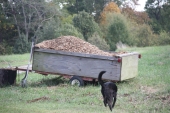








P Lyons wrote:Asphalt shingle disposal - Any mycoremediation potential? I have an isolated cabin with a deteriorated asphalt roof covered in moss and pine needles to dispose of.












Josh Cusack wrote:I had a couple of questions regarding a wildflower garden that I converted from lawn, which was sprayed a few times a year with broadleaf weed herbicide. The first being how much should I be concerned considering that I was able to grow wildflowers in this spot last year, could it really be all that bad. My second question is, if I did inoculate the area with the white rot fungi, like you suggested, while the wildflowers were growing would it be detrimental to them? I know for a fact broadleaf herbicides were used but I am not exactly sure which ones.




Uwe Wiedemann wrote:
John Elliott wrote:
I always wonder if mushrooms are so great in sweeping up toxins are they toxic waste after sweeping up? For example they take up a lot of
radiation and it is still not advisable to eat European mushrooms. Or do the mushroom break the heavy metals, radioactive elements and other poisons down?
Elements are called that because they can't be broken down. Some elements we need (N,P,K) and so we look for these in fertilizers and try to keep them cycling in the environment . Others, like heavy metals, can accumulate to problem levels. At that point, if there is a plant or a fungus that bioaccumulates it, that plant or fungus is going to be toxic.
I heard something different from a professor in ecology and a mycological society: It's right that fungi take up heavy metals, but these are bound and not available from passing our digestive tract. Mushrooms contain a lot of indigestible substance, which passes right through. That also means, the radioactive elements, if they are there, pass through (they are heavy metals). The danger with radioactive isotopes is, when they are deposited somewhere in the body. The danger from having a few isotopes passing through is very little compared to a long term exposure. I have collected and eaten mushrooms from the woods every year since Chernobyl and I don't feel any negative effects. I think this fear of mushrooms, 2000 km away from Chernobyl, is and was from the beginning WAY unrealistic.
Seeking a long-term partner to establish forest garden. Keen to find that person and happy to just make some friends. http://www.permies.com/t/50938/singles/Male-Edinburgh-Scotland-seeks-soulmate




See the Radical Mycology book—a compendium of all things fungi—here: http://bit.ly/rmchthaeus




Neil Layton wrote:I am really concerned about some of the material in this thread suggesting that mushrooms may make heavy metals less biologically available. I've tried to confirm this and failed.









P Lyons wrote:Asphalt shingle disposal - Any mycoremediation potential? I have an isolated cabin with a deteriorated asphalt roof covered in moss and pine needles to dispose of.
List of Bryant RedHawk's Epic Soil Series Threads We love visitors, that's why we live in a secluded cabin deep in the woods. "Buzzard's Roost (Asnikiye Heca) Farm." Promoting permaculture to save our planet.
















Faison Zutavern wrote:All this talk about using mushrooms to break down oil makes me want to try piling all my poison ivy in one spot, then innoculating with mushrooms to try breaking down the Urushiol.
List of Bryant RedHawk's Epic Soil Series Threads We love visitors, that's why we live in a secluded cabin deep in the woods. "Buzzard's Roost (Asnikiye Heca) Farm." Promoting permaculture to save our planet.




Bryant RedHawk wrote:That will actually work, it takes about two years for full break down of plant fibers (first to go) and the Urushiol (last to go), use several different species of mushroom caps to make your slurries and use as much slurry as it takes to soak the heap of vegetative materials.




John Elliott wrote:
Next time you see a mushroom, pick it up and take it home. Identify it. Find out where it will help in your permaculture. Blend it up to make some inoculation medium and apply it where it will do some good.
Still able to dream.


|
If tomatoes are a fruit, then ketchup must be a jam. Taste this tiny ad:
Freaky Cheap Heat - 2 hour movie - HD streaming
https://permies.com/wiki/238453/Freaky-Cheap-Heat-hour-movie
|




